It is easy to forget, as one is looking at old patents online, that not every inventor spoke English. I’ve looked at several interesting non-english patents in the past, and stumbled over an interesting looking one today too. It is for how to do attach a handle to your shaving apparatus. Or to put it in a different way; a handle attachment to your razor.
Patented by Paul Druseidt, the invention gives a razor that both pack flat and is easy to assemble. It consists of a normal-ish razor head and a U-shaped handle made from spring steel. The handle is ever so slightly smaller than the head of the razor and can nestle inside it.
Patent drawing from German patent 323,451
The key is the shape of the recesses or hole on the underside of the razor. The keyhole, if you will. As can be seen from the drawing, it was longer one way than the other, and had arches or troughs on either side.
The U-shaped handle was, as mentioned, springy. You would insert it along the long axis of the hole, then twist it 90°. The arches on either side would stop it from slipping back, and the tension of the spring steel would hold it in place. After shaving the handle could be twisted back, removed, and placed against the inside of the razor head
Or, to quote the patent;
>…der U-förmig gebogene Handgriff 6 zwecks Befestigung an der Kammplatte 2 mit seinen federnden Enden 5 in zwei unter der Kammplatte vorgesehene muldenförmige Aussparungen 4 eingeführt und sodann um 90° gedreht wird, wobei die federnden Enden in zwei weitere, enger aneinander liegende, muldenförmige Aussparungen 3 eintreten und in diesen festgehalten werden, während er nach Gebrauch aus den muldenförmigen Aussparungen herausgezogen und von unten gegen die Kammplatte gelegt wird.
For those whose German is a bit rusty, the autotranslated version runs as follows:
>…the U-shaped curved handle 6 for attachment to the comb plate 2 with its resilient Ends 5 inserted into two trough-shaped recesses 4 provided under the comb plate and then rotated by 90 °, the resilient ends in two more, narrower Adjacent, trough-shaped recesses 3 enter and held in these while he is pulled out of the trough-shaped recesses after use and is placed against the comb plate from below.
All clear and fairly straight forward.
I though initially that a top cap could have been fastened by the pair of hook shaped projections on the bottom plate. I also though that these projections also would have acted as blade guides for a normal Gillette three hole blade.
Further research showed me that maybe was no top cap, and the hooks just held on to a proprietary blade. The first hint came in Waits’ Razor Compendium. Waits’ Compendium do mention a Druseidt razor – along with the similar Impero and Ratio razor. And in the description of the later, Waits states that “the special thick double-edged blade has two square holes and two centre oval dimples”.
Waits’ Compendium also mentions that “later versions has two pieces”, by which he seems to mean that at least the late production Ratio was made with a top cap. This in turn matches with pictures I found in a thread over on Shaving Universe, which clearly shows a top cap.
A top cap, I might add, that looks very much like Waits’ description of a “special thick double edged blade”…
Was Waits just confusing a poor quality picture of a top cap for a proprietary blade? Quite possible. It could simply be that a lot of the Druseidt, Impero, and Ratio razors that have survived have lost their top caps over the years.
Interestingly all three of the razors mentioned also have u-shaped handles. But none of the three has the handle attachment method described in the patent. Instead they uses a swinging out handle, which still relies on spring pressure to lock in place.
Overall the Druseidt patent looks like it would make an interesting razor, possible more interesting than the Druseidt razors that were actually manufactured.
You can read the full text of Druseidt’s patent at Espacenet, or a translated version at Google Patents.
A razor can take up space in a gentleman’s vest-pocket… a problem several inventors searched for a solution to, including Mr Albert S Aloe. He came up with a folding razor all the way back in 1886.
Described, unsurprisingly, as a new and useful improvement in safety razors, Albert didn’t have the benefit of the thin replaceable blade. Like most razors of this era he had to work with a wedge blade. A wedge blade is chunkier than a modern razor blade, but also has the benefit that it can be stropped and honed.
In hindsight his razor is simple enough. A couple of pieces of sheet metal, shaped to hold and clamp a razor blade. The blade holder and guard were made to fold flat when not in use. In some ways you could see it as a folding version of John Monks’ razor.
Patent drawing for US patent 375,592
It is worth noting that the first claim in the patent isn’t the razor per se. Rather it is for the spiral guard, which was meant to ‘carry the lather endwise’ when the razor was used. Or in simpler words; keep the lather out of the way.
The blade was held in place by a spring loaded catch. This also made sure the distance between the edge and the guard stayed constant, even as the edge was gently worn away by stropping and honing. You could say the blade was self adjusting to keep it working as intended.
I see no reason why Aloe’s folding razor shouldn’t work as intended, nor any reason why a version couldn’t be made for a GEM blade. At the same time I see no reason why anyone would want one today, as it is unergonomic and looks like a kludge.
You can read the full patent for Aloe’s folding razor at Google Patents.
I little while ago I bought a Christy razor. It’s a fun and interesting razor, fairly unique compared to modern razor. And, as I mentioned, you can’t get blades any more, as the Christy blade (which existed in a couple of variations) went out of production sometime in the late 30’s.
Some of you wondered if I couldn’t get another blade to fit.. and the answer; no, not really. And this is why:
First off, apologies for the glare in some of these pictures – taking photos of shiny blades can be difficult.
From the top: Common DE, GEM, Injector, and Christy blades.
No other blades are a good match – or even a partial match, for the Christy. It’s not just a matter of width and thickness, but more importantly of the inclined blade alignment cut-outs on the sides of the Christy.
The Christy compared to a common double edged blade.
You could trim a DE to match part of the outline of the Christy. However the slot means you can’t replicate the top part of the alignment cut-outs. And the cut-outs are also the blade stops, so there would be nothing keeping the blade in place. Nor would anything stop it from sliding too far forward.
The Christy compared to a GEM blade.
The GEM is the best candidate for conversion. But you’ll have to despine it, trim some of the top, do some very careful trimming of the length, and nibble a little for the shape of the alignment cut-outs. And even so the alignment won’t work, as the cut-outs on the GEM are too deep.
The Christy comparted to an injector blade
The injector blade seems to be a no-go from the start. Yes, you could trim a little to match the bottom of the alignment cut-outs, since the length is a good fit. But since the cut-outs are also the blade stops, you’ll have the same problems as you would with a DE.
So the question still remains; Where can I get a Christy blade today? I have this interesting old razor, and I can’t shave with it.
Razor: Autostrop VC2 Blade: Feather FHS-10 Brush: Vie-Long #14033 Pre-Shave: Proraso Pre Shave Cream Lather: Asylum Shave Works Frankincense & Myrrh Aftershave: Asylum Shave Works Frankincense & Myrrh Additional Care: Alum Block
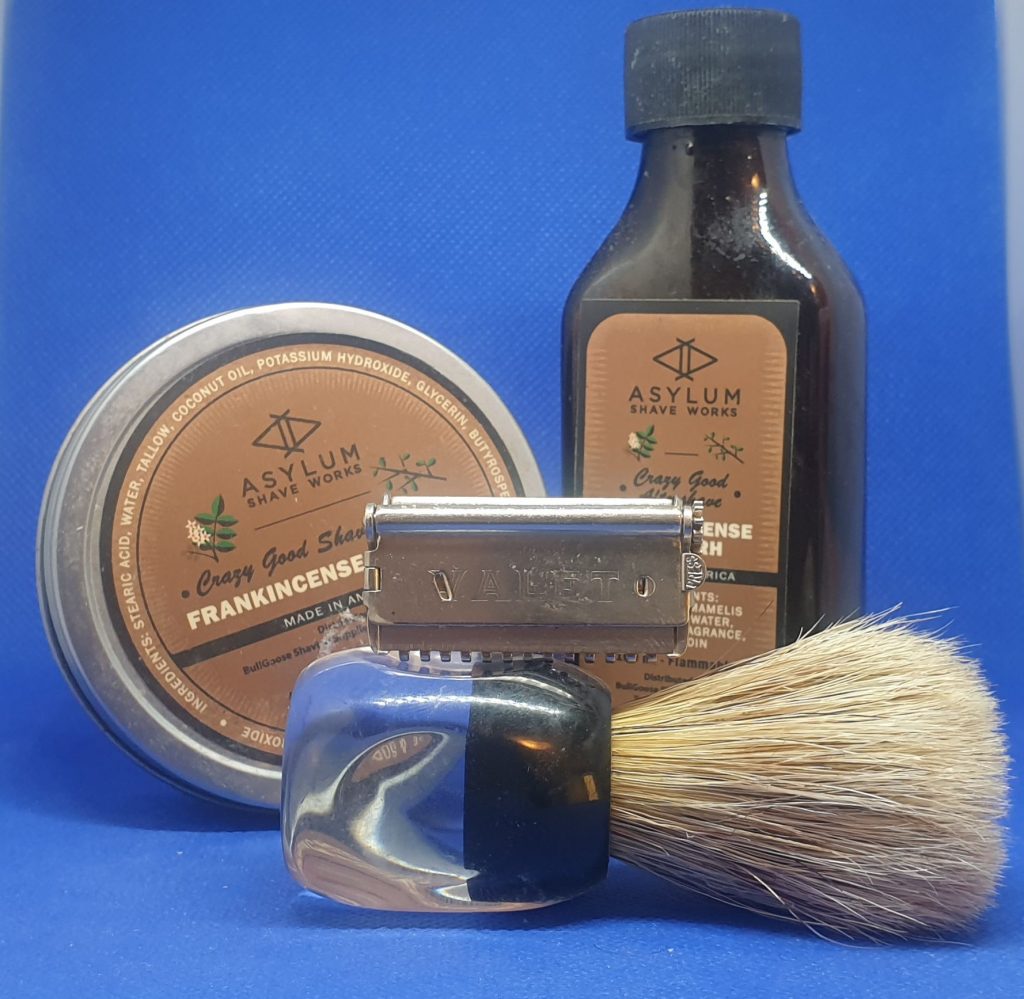
It is seventy-nine years since the end of the War in the European Theatre, and I had a wonderful Wednesday shave.
Still waffling on the strop yes. But I'm not sure how that would affect the razor, especially as I started with a fresh blade.
A little while ago I bought a Valet Autostrop, almost by accident.
Unlike some vintage razors, you can still get blades for the Valet. And since I consider myself a shaver and not a collector, I got some blades and gave the Valet a spin to see if it belongs in my rotation.
The jury is still out on that though. Yes, I have shaved with it for a week, but a few shaves isn’t enough to show me just how good the Valet is.
Of how bad, for that matter.
The Valet Autostrop in question
It is – mechanically speaking – a very interesting razor. The way it secures the blade is different. The way it aligns the blade is different – yet similar. And the blade itself is different too.
Then you have the whole “push lever to release blade holder so it swings freely”. It is there so you could strop the blade – hence the name Autostrop. The strop actually goes through the razor, and the blade swung in the right direction as you pulled the razor along the strop. The whole thing was highlighted in advertisements and animatronic displays.
Historically it is also an interesting razor. You could consider it an also-ran when compared to Gillette – but also compared to the GEMs and even Schick’s Injectors. It is more complicated than most other razors. The construction is mostly sheet metal. It requires it’s own blades. And yet it survived, unlike other also-rans like the Christy or the CURBO.
As mentioned, blades are still made for it – although you have a lot less choice in blades than you do for a DE or even an Injector blade. Some report using a de-spined GEM-blade in their Valets – I can see that in the early A, B, and VC1 perhaps… but in the VC2 and later you have to work around the alignment bumps. Bumps which, by the way, different between various models of the razor – but always lined up with part of the VALET name cut out in the blade.
A week of shaves with the Valet Autostrop VC2
As far as the shave goes… the Valet Autostrop VC2 is pretty middle of the road.
It is not great, but not terrible.
It don’t nip or scrape, but it is a bit on the mild side of things. Getting the angle right was a little tricky, until I realised that like my GEM razors you can simply place the top cap flat against the face. The left side blade stop has a small burr on it I probably ought to take a small file to. People tell me the FHS-10 blade dulls quickly, but I didn’t notice much degradation over the course of a week.
Will the Valet VC2 make it into my permanent rotation? How long will the blade last me? I don’t know.
I don’t know yet, that is. I’m heading into the second week of shaving with it. There might be a third.
- Razor: Autostrop VC2
- Blade: Feather FHS-10
- Brush: Wilkinson Sword Badger
- Pre-Shave: Proraso Pre Shave Cream
- Lather: GzD Shavestick
- Aftershave: Barber No3 Marmara
- Additional Care: Alum Block
Another week and another shave. The blade still keeps up, although I can tell it is not quite as smooth.
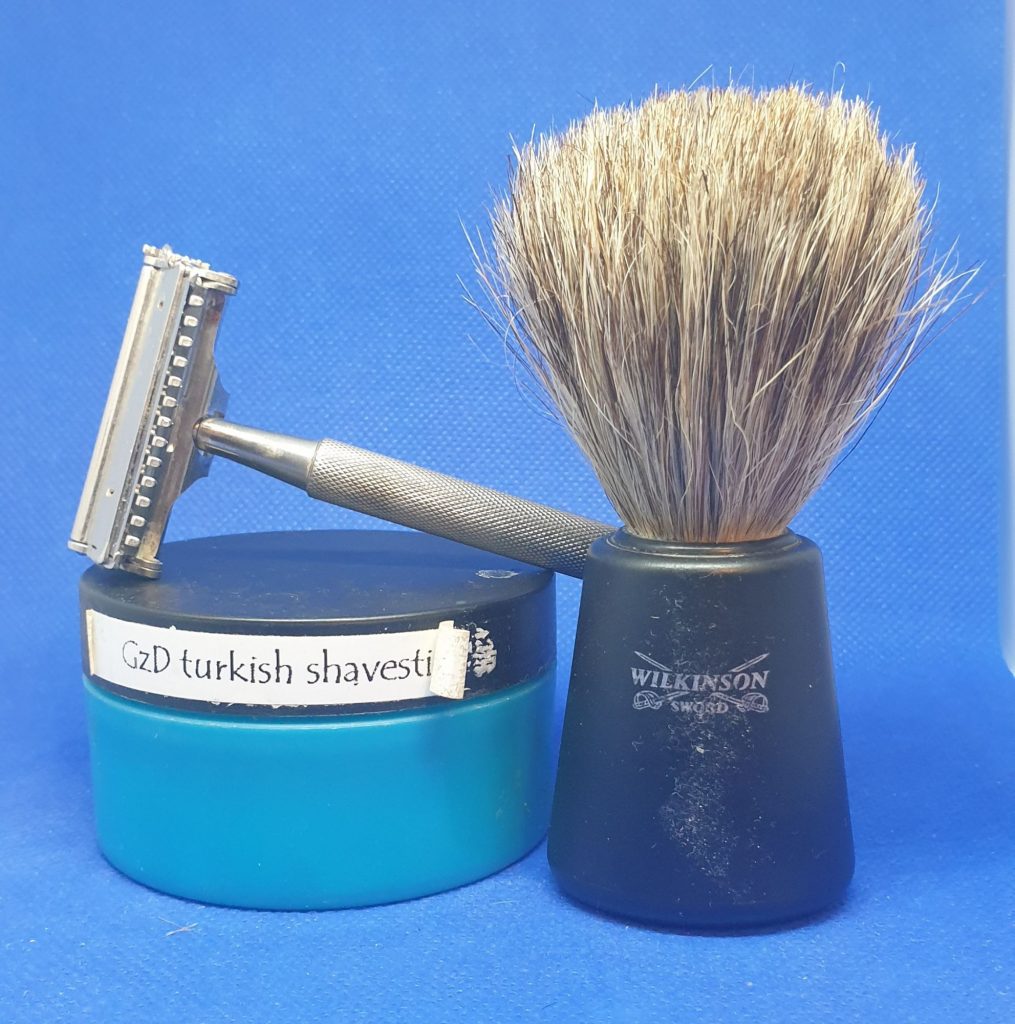
If I remember later, I can post a comparison of the blade vs other blades like the GEM and a standard DE
We know how it goes. Peacefully puttering around on the internet, and boom: You accidentally bought two vintage razors. Earlier this week we looked at one of them, and today we’ll have a peek at the other. The other being a Christy razor.
Christy, like the CURBO, Diamond Edge, and others, were aiming for the low end of the shaving marked. Whereas Gillette and others were offering affordable razors, Christy’s razors were cheap or even free.
The seller had mislabelled this in their classified ad; the seller had it listed as an Gillette. It came in the original box, with a couple of spare blades.
My Christy is a very neat little razor. It is sleek and lightweight, and has a couple of interesting features.
The blade has a unique shape, as can be seen in the pictures. The shape of the blade can be traced to US patent 1,563,724, filed in 1921. The rest of the razor don’t match that patent though, but rather partly matches a 1927 advertisement for the Christy with a ‘massage bar‘. Apart from lacking the massage bar, that is.
The ears and angled cut-outs on the blades matches to bumps on the bottom plate. These bumps acts as both alignment guides and blade stops. Two raised ears on the bottom plate helps guide the plate onto the top cap. The top cap has a tab that is wrapped under it, which both hold the handle and – more importantly – presses the bottom plate up against the top cap. This locks the razor together securely.
The razor also came with two spare blades, wrapped in an old Gillette blade wrapper.
My best guess is that this Christy dates from between 1921 and 1927. But that is mostly based on the patent and the advertisement, so it’s a tenuis guess at best.
While there is nothing wrong with the razor itself – at least nothing that some soap and TLC can’t fix – I’m stuck as far as blades goes. To the best of my knowledge, no one makes Christy blades no more. Nor have I had much luck finding a guide on how to modify other blades to fit.
I'm not sure yet. One step at a time and all that.
Well, at least one shave so far :P
We’ve all been there. You are peacefully puttering around on the internet, and suddenly you’ve accidentally bought a razor. Or two, as I happened to do a couple of weeks ago. So let’s have a look at one of my latest accidental buys; a Valet Autostrop VC1. At least it was listed as a VC1 – right now I’m less certain, as the blade holder is a much closer match to the description of a Valet VC2.
From what both the internet and Waits’ Compendium tells me, the VC1 was introduced in 1922. It likely stayed in production until 1928, when the VC2 came out. The VC2 was manufactured until 1935. The VC3 replaced it, and was in turn replaced by the VC4 in 1940. Production seems to have ended in 1946.
The main difference between the VC2 and the VB2 – which was manufactured at the same time – was that the VB2 was supposed to be adjustable (according to Waits at least).
My Autostrop – whatever model it is – came in the original box. And with the original strap. But without any original blades, which I would never have used anyway.
Box has definitely seen better days, but it is a cardboard box that’s almost one hundred years old.
The strop has dried out, which is unsurprising, but looks to be in remarkable good shape otherwise. I am assuming some leather grease will soften it up if desired.
For being old, it is in quite good shape. A bit of grime, but not much in the way of plating loss.
The Autostrop has a blade holder that differs from pretty much any other razor I’ve owned. You have to swing the holder up and over – as you would if you were to strop the blade – before opening a flap. The top cap has a pair of studs, that aligns with cut-outs in the blade and flap. The blade holder is held in place by pressing the guard against it, controlled by the lever on the back of the head.
You can still buy blades that fit the Autostrop. The Feather FHS-10, to be precise. So I naturally bought some. If the razor could be shaved with, it should be shaved with – I’m a shaver, not a collector.
But that also means that a century of dust and grime had to be cleaned of…
The patent number referred to at the underside of the razor head is British Patent 184,808 by the way. The 1922 patent is the same as the US patent 1,492,246, filed in 1921 but not granted until 1924. It makes sense that the razor refers to the British patent, as they text on the underside of the blade holder flap refers to Autostrop Safety Razor Co Ltd, London, England.
Overall I’m very happy with the condition of the razor, and even happier by the fact that I can get blades for it.
- Razor: Autostrop VC2
- Blade: Feather FHS-10
- Brush: Semogue TSN LE 2012
- Pre-Shave: Proraso Pre Shave Cream
- Lather: Taylor of Old Bond Street Peppermint
- Aftershave: Barber No3 Marmara
- Additional Care: Alum Block
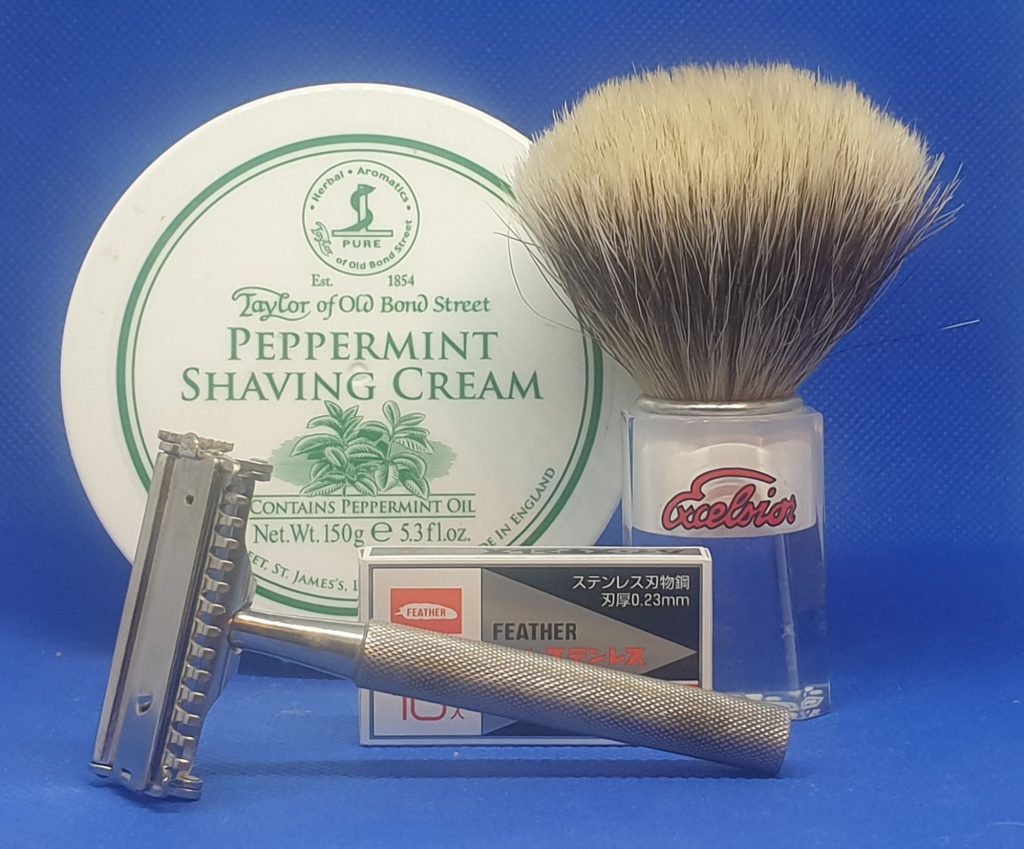
A new week. A new shave. And a new-to-me razor. And for the first time in years I actually had to think about how to insert the blade.
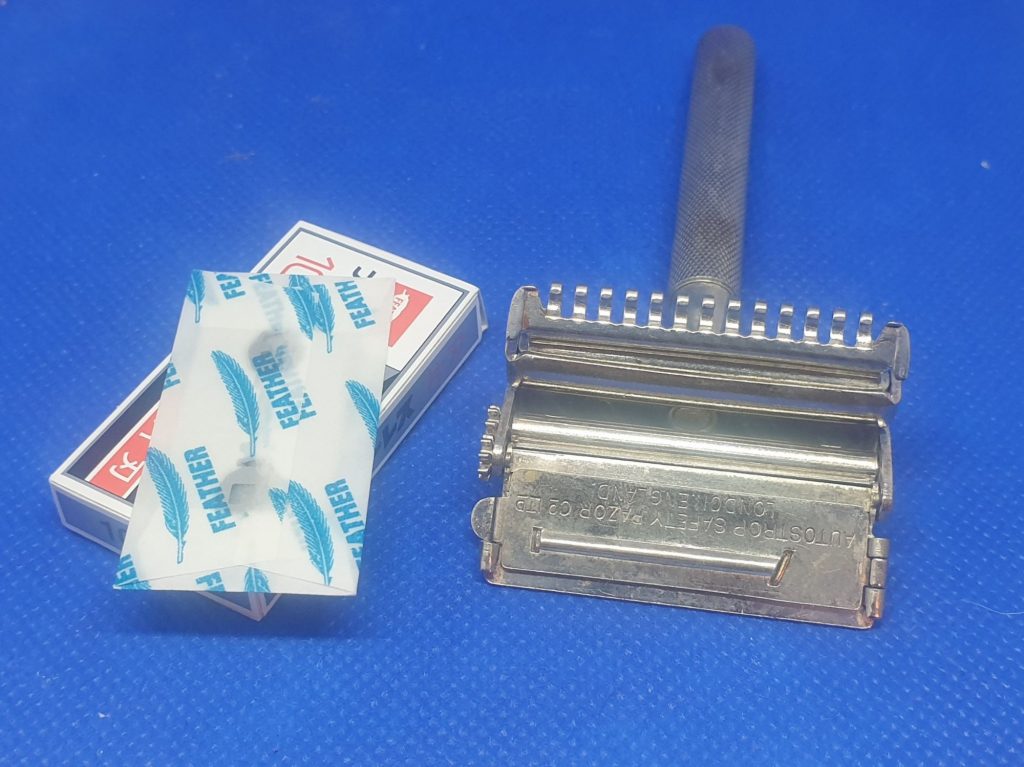
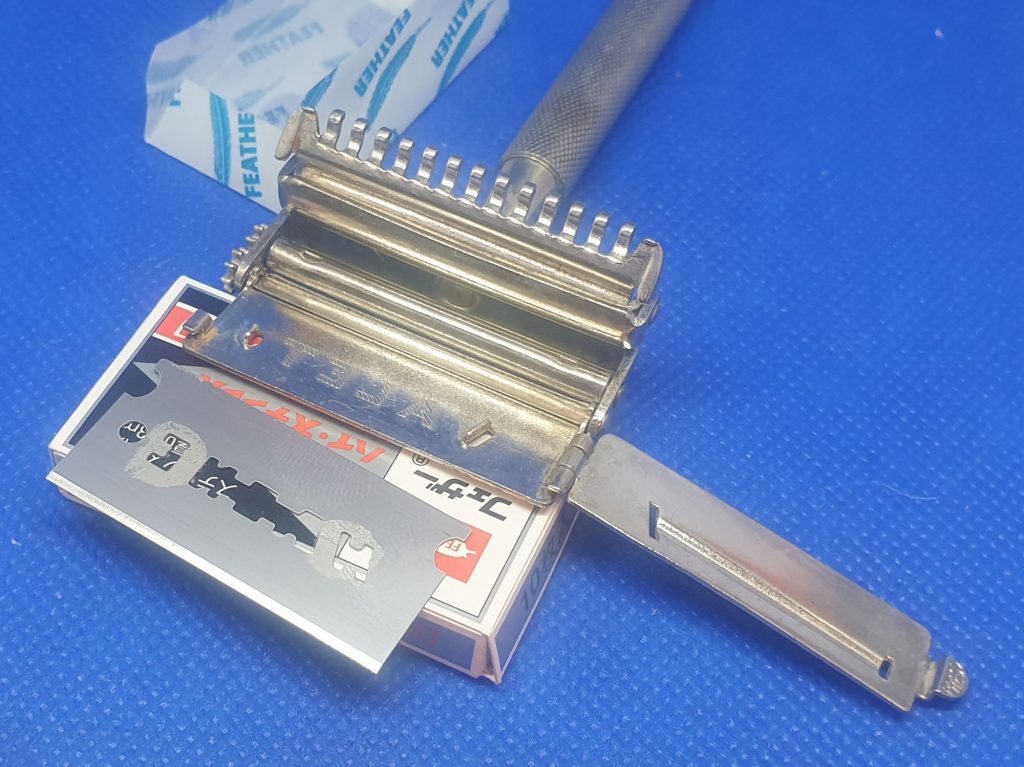
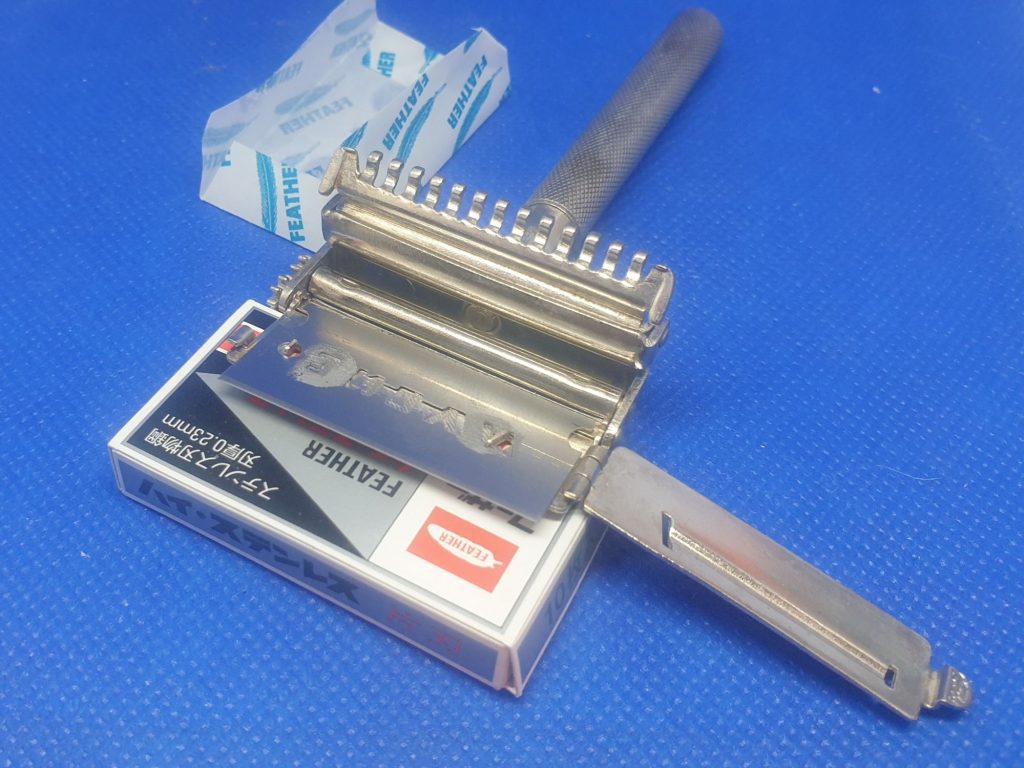
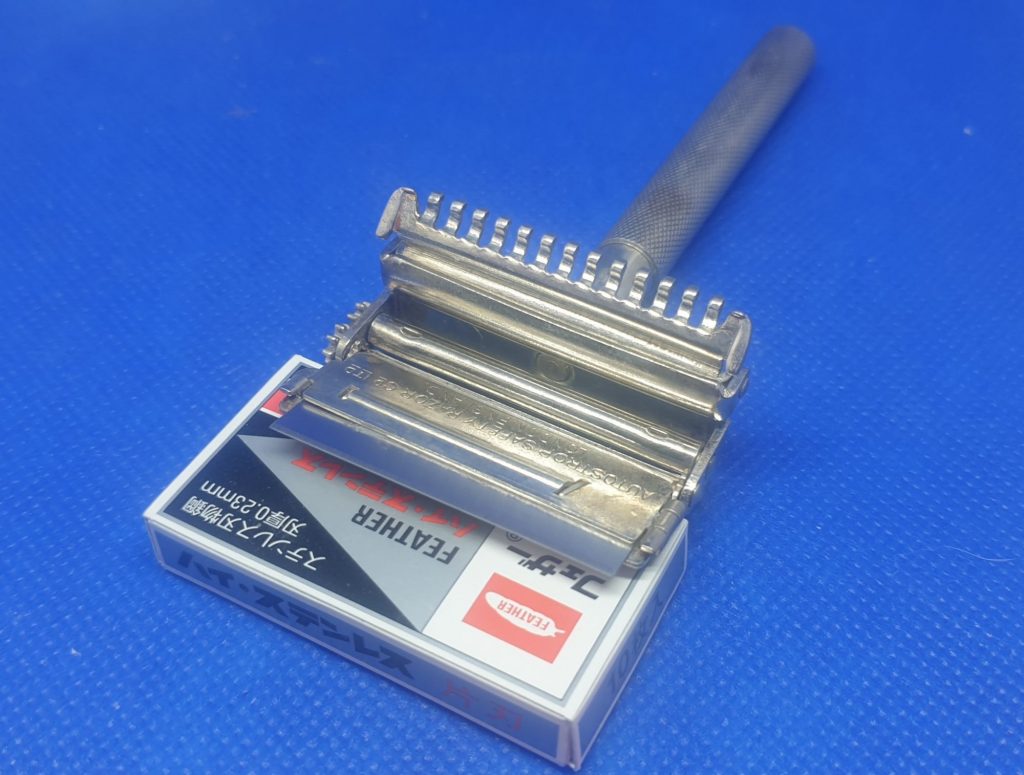
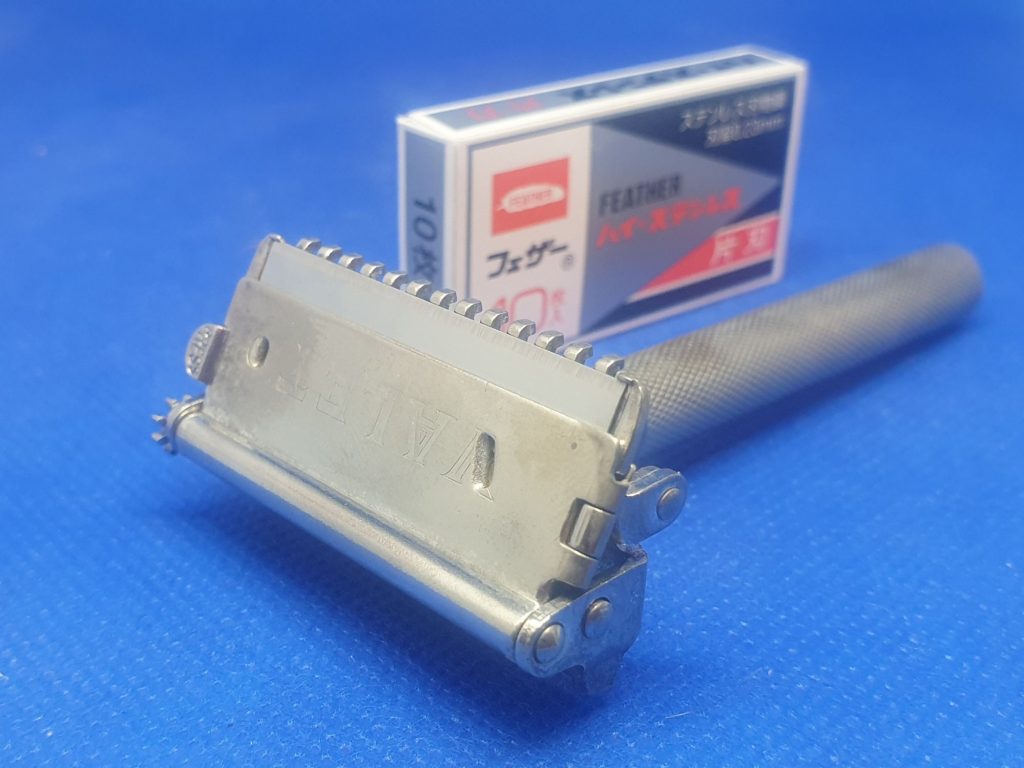
Have a Double Edged razor you enjoy? Want to use your favourite GEM or other Single Edged blade? Fear not, Walter Althof1 patented the solution in 1923; An adapter that let you use a single edged blade in a double edged razor.
Well, more on than in. But even so, you could use your favourite single edged blade in on with your favourite double edged razor.
As to why you should is a completely different question. And one the patent text fails to address. What it does talk about though, is the position of your hand while shaving. To quote:
>The object of the invention is to produce a device capable of being assembled with the ordinary safety razor of the double edge blade type to adapt said razor for use with a single edge blade. Further, safety razors of the double edge blade type support the blade in a position practically at right angles to the longitudinal axis or extension of the handle so that the handle must be held at substantially right angles to the surface to be shaved. Such a position is unnatural, and somewhat difficult for the hand of the operator to assume, and another object of the invention is to produce a simple and inexpensive device, capable of assemblage with a razor of the double-edge blade type that will support a blade in a normally inclined position disposed at a substantial angle to the plane perpendicular to the longitudinal axis of the handle. Thus, a razor substantially of the character known as “hoe type” is produced.
The actual device patented is fairly straight forward. The adapter is little more than a bent piece of sheet metal.
Patent drawing for US patent 1,453,487
The adapter has a fairly complex shape, but should be easy to manufacture in a suitable press. Or it could – conceivably – be an extruded metal profile. The bottom part is concave to fit between the bottom plate and top cap of the razor. The upper part is shaped to hold the blade. A small flange (marked 16 on the drawing) presses the blade against the top cap and bottom plate.
The patent also suggests a special blade, with a groove about half way down the blade that will engage the top cap. But I can easily see using a GEM blade in the adapter, if the design is adjusted so that the flange would grip under the spine of the blade.
As designed, the adapter is suitable for razors using three posts for blade alignment. It should be possible to redesign it for other razors too, by replacing the three cut-outs with the same slot as a normal double edged razor blade has.
To use it, you would place the adapter on the razor, place the blade in the adapter, and tighten the handle. And that is about it. Just shave as normal, just remember to check the angle of attack.
I see no reason why the adapter shouldn’t work as intended. I just don’t see a compelling reason why you should use it. But even so.. if someone offered this for sale, I would probably buy one. Or two…
You can read the full patent text for the adapter to use SE Blades with DE Razors on Google Patents, as well as over on razors.click.
---
- Of the city of Geneva, in the county of Ontario, in the State of New York
- Razor: Schick E2
- Blade: Personna Injector
- Brush: Wilkinson Sword Badger
- Pre-Shave: Proraso Pre Shave Cream
- Lather: Arko Shavestick
- Aftershave: Barber No3 Marmara
- Additional Care: Alum Block
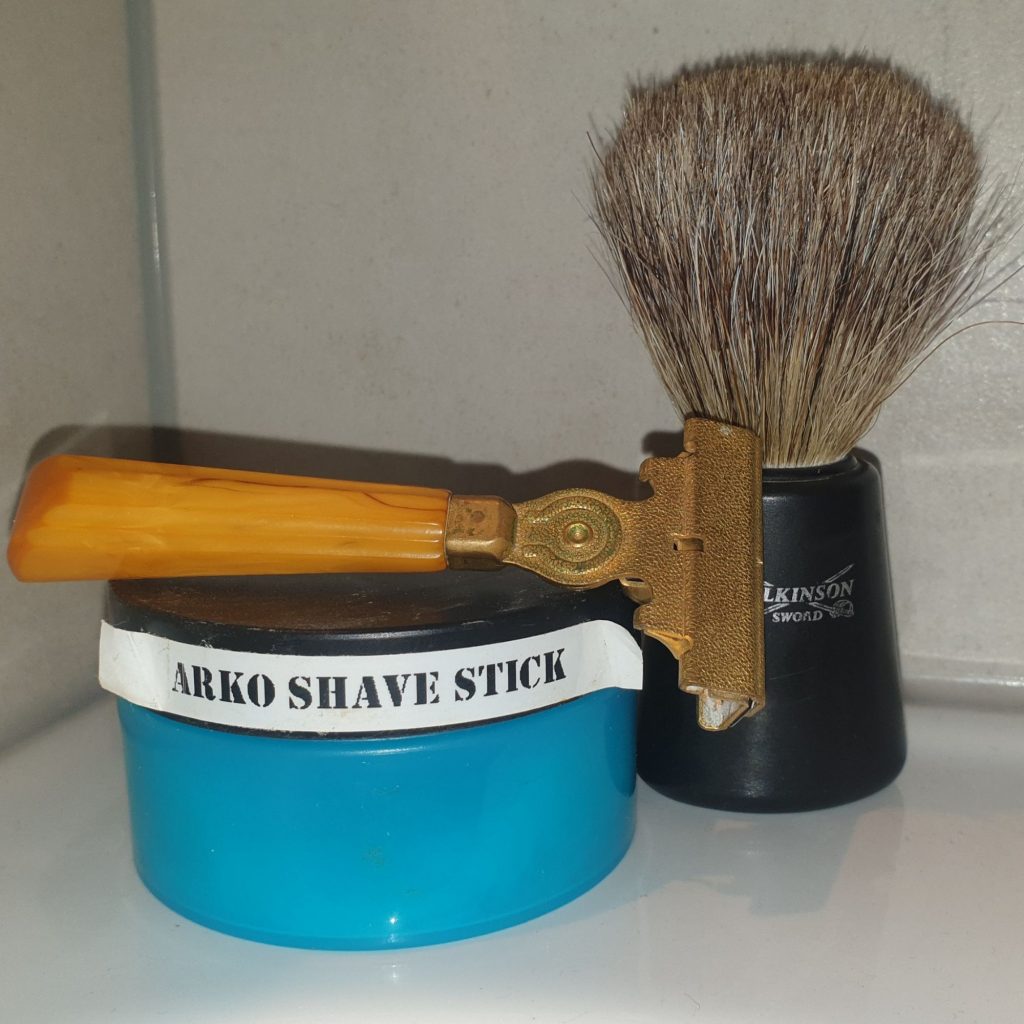
Another fantastic Friday shave. The last Schick shave for now, next week will be a GEM – unless the postman comes through with a package this weekend.
- Razor: Schick E2
- Blade: Personna Injector
- Brush: Semogue TSN LE 2012
- Pre-Shave: Proraso Pre Shave Cream
- Lather: B&M Latha Oceana
- Aftershave: Barber No3 Marmara
- Additional Care: Alum Block
A fine and fast Friday shave.
I am gettting a Autostrop VC1 in the mail any day now, so I will see what I find :P
…in addition to being self-stropping. According to the advertisement, that is. Just how instantly adjustable it truly was is a different matter. I do suspect less so than the copywriter claimed.
Valet 1918 advertisement
>By a touch on the adjusting lug you can vary the distance between the blade and the guard with supreme precision and accuracy, according to the toughness of your beard or the tenderness of your skin.
From what I can tell, the “adjusting lug” they are talking about is the lever you use to release the blade for stropping. Which means that if you use it to lift the blade away from the guard, the blade is less well supported for the actual shaving.
And I might be less tough and more tender… but I do not want to shave with an unsupported blade.
As for what an instantly adjustable Valet would cost you.. .21 shilling is 1.05 pounds, also known as one Guinea (British pre-decimal currency was weird). and if we adjust for inflation, that would be 49.39£ (57.70€ / 61.89$ / 670.05 NOK) today. Not a cheap razor, but not terrible expensive either.
- Razor: Schick E2
- Blade: Personna Injector
- Brush: Brush Experimental Alpha
- Pre-Shave: Proraso Pre Shave Cream
- Lather: Body Shop Maco Root & Aloe
- Aftershave: Barber No3 Marmara
- Additional Care: Alum Block
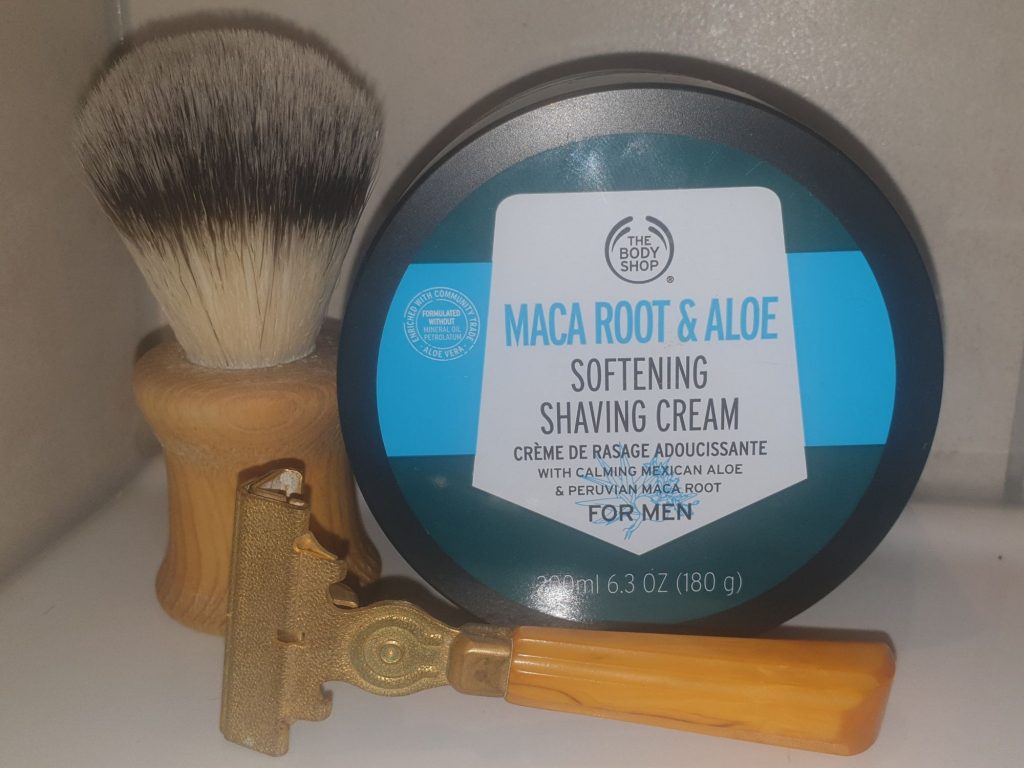
Another week, another shave – with an 83 year old razor. Who said things don’t last? All you have to do is to take care of them…
Not only did Jacob Schick think up various repeating magazine razors – he also came up with the idea of a combined sales package and razor. Or, put another way, a razor blade dispenser with a built in razor. Or, arguably, a disposable razors that came with a supply of blades.
And the one I’ll discuss today isn’t even his first one… but the improved version.
Both versions of the combined sales package and razor aimed making a small and convenient blade package and razor that could fit in your vest pocket. Having looked at both, this version is smaller, handier, and requires less parts. Which is good when the whole point is to make it cheap. Or as the patent put’s it:
>This invention relates to an improved article which forms a shaving unit and consists of a combined blade package and razor, the blade package being in the form of a sales package so that the article can be supplied filled with blades and has an opening through which the blades can be fed, one at a time. It is preferably made so that it will be difficult to refill it all this in view of the fact that a large supply of blades can be furnished with the package and the whole device is so cheap that when the supply of blades is exhausted the article can be thrown away.
The whole thing takes the form of a small aluminium box, about as tall as it is wide. The blade looks to be about the size of an injector blade. If so the sales package and razor would be about 4 cm (1 6/10 inches) square, and about 1 cm ( 2/5 inches) thick. It’s partly a machined aluminium lump, and partly sheet metal cover.
Patent drawing from US patent 1,767,707
One half of the package was a blade dispenser. A slit in the end allowed the user to slide blades. And a pair of springs and a plate kept pressure on the stack of blades.
The other half of the combination package and razor is, unsurprisingly, the razor. A guard is machined into the metal body that makes up the box. The sheet metal cover forms the top cap and blade retainer. The guard and blade is covered with a, well, cover.
To change the blade, the user would press on the back of the combined sales package and razor. This would bend the sheet metal cover into an recess machined into the aluminium body, which would bend the top cap up. A quick shake would release the old blade. The old blade could then be user to push a new blade out enough for it to be pulled or pushed the rest of the way. Another push on the back would oven the cap again, so the new blade could be installed.
All in all it’s a handy little package. And while it might be a little more awkward to shave with than most razors, it would still make for a handy travel razor. Or a neat razor to keep in your vest pocket, so you can have a quick shave when you need one.
I can also see this being cast from a cheaper alloy like zamak, of even from injection moulded plastic. The only real drawback I see is the awkward shape. That, and the fact that the market today is overfilled with inexpensive disposable razors.
You can read the full patent for Jacob’s combined sales package and razor at Google Patents.
- Razor: Schick G4
- Blade: Personna Injector
- Brush: Artesania Romera Manchurian Badger, imitation horn
- Pre-Shave: Proraso Pre Shave Cream
- Lather: Asylum Shave Works Colonia
- Aftershave: Saponificio Varesino Tundra Artica
- Additional Care: Alum Block
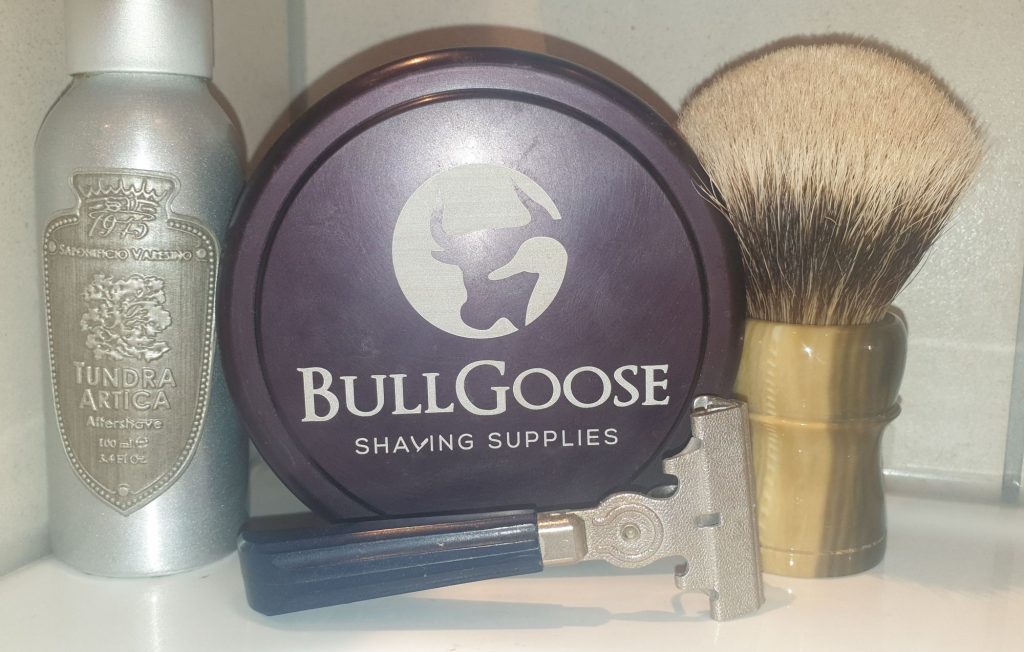
Another wonderful Wednesday shave.
The brush, soap, and soap holder all came from Phil’s shop some years ago, while the razor was from the ‘Nook’s BST.
Schick didn’t go directly from his first patent to the Type A. In between he patented a second repeating razor, that has a fair bit in common with the first patent.
Unlike the first patent, the second patent specifically mentions the use of a blade package. It extols the virtue of the package as a sanitary improvement. To quote:
>The holder and the stack of blades in it form a unit that can be inserted into the razor without the user handling an individual blade either to in sort it in the holder or to place it in shaving position. The holder and the blades form an expendable unit so that the purchaser simply inserts the filled holder into the razor and after the blades are used up the holder is thrown away. This not only provides for economy in manufacture and saves time in using the razor, but it also guards against injury as the user need not handle an individual blade at any time.
>Furthermore, this package insures a sanitary razor as when the packing of blades in a holder is done automatically the individual blades need not be handled by anyone from the time they are packed until they are used for shaving.
Conceptually there is not that much difference between Jacob’s first and second repeating razor. On both you manipulated part of the razor to make the top cap move back and forth.
But the devil is in the details, as always.
Patent drawing from US patent 1,584,811
Instead of twisting the handle back and forth, on the second patent you twisted the knob at the bottom. This moved – through a cam and a bell crank – the top plate back far enough that it would pick up a blade from the magazine. Twisting the knob further would cause the top plate would swing forward, ejecting the old blade and presenting a new one for use.
Or as the patent text puts it:
>The means shown for operating the top plate consists of an arm 17 which is pivoted on a pin 18, this pivotal point being the center of the radius of the opposed faces of the top plate and the guard. The arm has an extension 19 which fits in a slot 20 in a collar 21 thus forming a cam on the end of the stem 22 the projecting end 23 of which is beyond the end of the handle and thus available for easy manipulation.
>It will be seen from this that when the finger piece 23 is turned the cam groove 20 will actuate the finger 19 and this in turn swings the arm 17 which being secured to the top plate moves the top plate to the desired position. Suitable insignia can be placed on the finger piece or handle to indicate relative positions and directions of operation for placing the blade.
There are three major improvements, as I see them, in Jacob’s second repeating razor.
Firstly, the mechanism is a fair bit neater. Gone are the rack and spur gears, replaced by a cam and a bell crank. The back and forth motion is replaced by a full rotation of the knob.
Secondly, the blades are kept in a carrier. This means that the shaver won’t have to manipulate a stack of thin, razor sharp razor blades.
And thirdly, it just looks better.
The downsides are much the same as in the first patent. The head don’t fold, meaning it is less suitable as a travel razor. And the blade magazine is right up by the wet end… which could cause carbon blades to rust. With modern stainless blades, the risk of corrosion is much reduced.
My only concern is that the short end of the bell crank that rides in the cam track looks a bit flimsy. Apart from that, I would buy this razor if someone manufactured it today.
You can read the full patent for Jacob’s second repeating razor at Google Patents.
- Razor: Schick G4
- Blade: Personna Injector
- Brush: Wilkinson Sword Badger
- Pre-Shave: Proraso Pre Shave Cream
- Aftershave: Barber No3 Marmara
- Additional Care: Alum Block
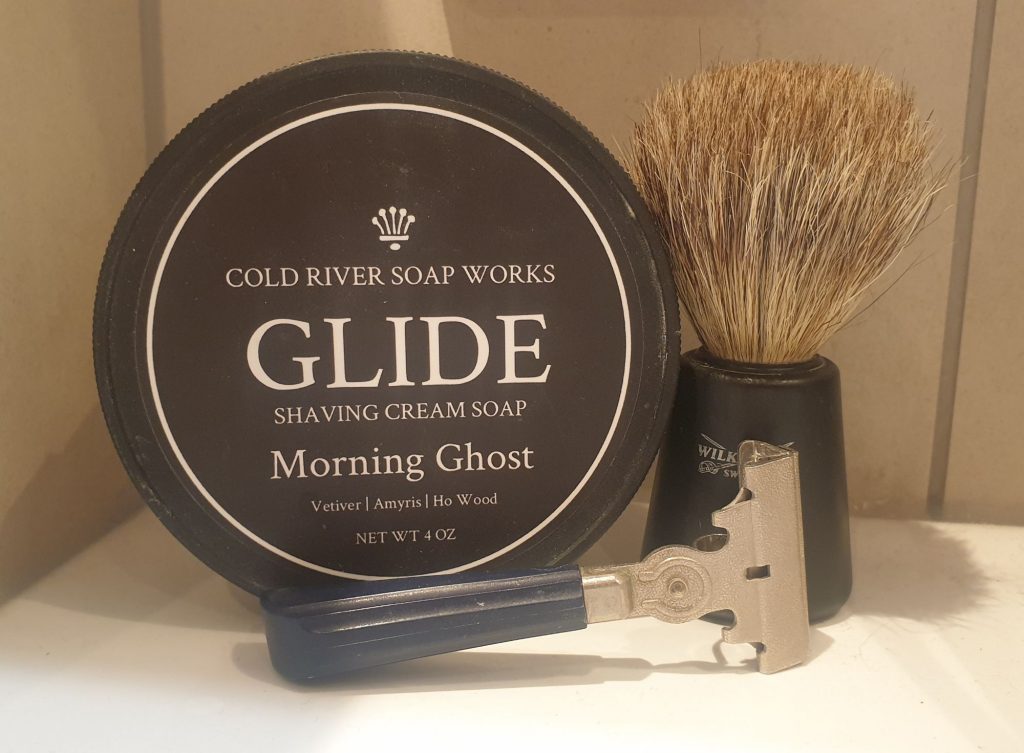
A fun and fast midweek shave.
We all know that the Type A was the first Magazine Repeating Razor. But nothing gets created in a vacuum, and Jacob Schick filed a patent for his first repeating razor as early as 1921. And while it could hold a blade pack in the handle as the later types A through C, the main magazine was in the razor’s head.
As I’ve said over and over again, an invention is an attempt to solve a problem. And reading Jacob’s patent, it is clear that his repeating razor was aimed at simplifying the act of changing blades. To quote:
>This invention relates to an improved safety razor which is adapted to use what are commonly known as wafer blades, that is, thin blades, these blades being held within the razor and adapted to be fed therefrom into shaving position when desired, and can be pushed beyond the shaving position for ejection or either to be replaced by a new blade or for the purpose of washing the blade and the razor.
The idea was both simpler and more complex than the later Magazine Repeating Razors. Unlike the later, the head didn’t need to rotate through 90° to be reloaded. On the other hand, the relatively simple plunger hadn't come into existence yet. Instead the top plate of the head was made to pivot, controlled by the twisting of the handle.
Patent drawing from US patent 1,452,935
As can be seen from the drawing, the handle can rotate in relation to the neck and head. A spur gear is secured to the stem the handle rotates around. This spur gear interacts with a rack that connects to the top plate with a pair of lever arms.
Twist the handle in one direction, the used blade is ejected. Twist it in the opposite direction, an edge on the underside of the top plate picks up a new blade. Return the handle to the centre, and you’re good to shave.
It’s a fairly simple system, and it has both good points and bad points compared to the later Magazine Repeating Razors.
On the plus side, there is no blade carrier as you’ll find on the later repeating razors. No carrier means you can’t insert it the wrong way… which incidentally means that you’ll jam up the inner workings. And you can keep a spare pack of blades in the hollow handle.
As for the negatives? Well, the razor head don’t fold, meaning this repeating razor is less well suited for travel. The blade stack is kept close to the actual shave, so you’ll risk corrosion. And unless there is a detent, there is the chance of the handle twisting as you shave.
I can see why Jacob didn’t put this repeating razor into production. The later magazine repeaters are both more convenient with their folding heads, and there was less risk of carbon steel blades rusting. At the same time I can see this razor doing okay today, with stainless steel blades and less focus on portability.
You can read the full patent text for Jacob Schick’s first repeating razor at Google Patents.
- Razor: Schick G4
- Blade: Personna Injector
- Brush: Vie-Long #13051M
- Pre-Shave: Proraso Pre Shave Cream
- Lather: Cold River Soap Works’ Barbere Sapone
- Aftershave: Myrsol Aqua De Limón
- Additional Care: Alum Block
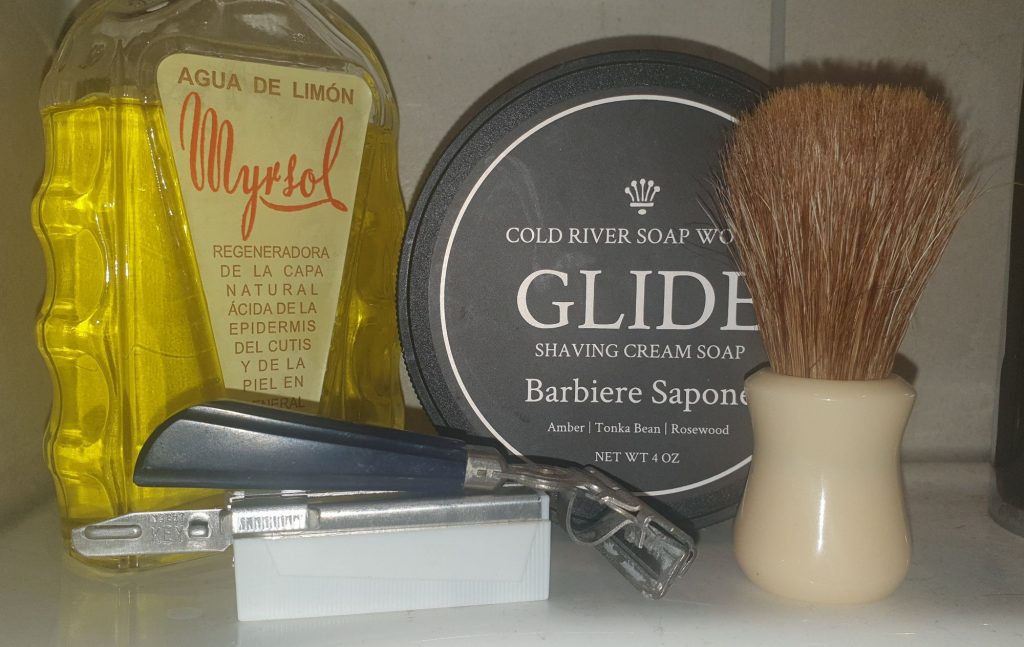
Another fine week, another great shave.
…at least if the old ad for the Bessegg blade is to be believed. Speaking as one of the menfolk, I’m inclined to agree.
I’ve talked about Bessegg before – covering both the blades and two ads for their razor. Today we have a blade advertisement, which according to the source is from 1935. The Bessegg factory operated from 1927 until 1961, so bare minimum the advertisement cannot be older or newer than that.
The Bessegg ad – talking to the menfolk
A quick translation;
>We menfolk don’t like to buy “cheap”. We want something good – something first class – BESSEGG > >BESSEGG BLADE > >“The new quality” – 25 øre per blade – Norwegian and good
Cheap, in context, don’t mean inexpensive. It means something cheaply or shoddily made. And as one of the menfolk, I can attest that I don’t want a cheap blade in my razor – but I’m more than happy to buy inexpensive blades if they are good.
For context, 25 øre in 1935 is 16 kroner and 23 øre today – or 1.52 USD / 1.40 EUR / 1.20 GBP.
Per blade.
So not cheap in the more vernacular meaning of the word either.
Disposable shaving brushes are something we’ve looked at before. As is brushes with replaceable – or exchangeable – knots. So in that respect the shaving brush with exchangeable fiber pad that Marguerite Faucon1 patented in 1921 isn’t earth shattering.
Marguerite ‘s brush with replaceable knot, or, as the original German patent calls it; Rasierpinsel mit auswechselbarem Faserbausch, is a pretty simple idea. But made delightfully complicated, if the drawing is anything to go by.2 There is claws, funnels, springs, and all sort of doodahs.
Patent drawing from German patent 321,121
I’ll let the machine translated text3 explain how it works:
>The handle shown in Figs. 4 to 6 is designed so that the Bags can be inserted and removed particularly easily; it contains four resilient claws 16, which tend to spring apart and through a screw spindle 17 is attached to a tube 18. Slides over this pipe a sleeve; this consists of an inner cylindrical spout 19, an outer one Grommet 2o and a union nut 21 which is screwed onto the grommet 2o. The rotation the sleeve is prevented by a pin 22 which slides in a groove 23 of the tube and is prevented from sliding off the sleeve by catches 24, 25. As soon as the Sleeve is pushed up on the tube (Fig. 5), it presses the claws 16 together and forces them to clamp the fiber ball i between them. – Simultaneously slides a detachable one fastened in the sleeve Knife 7 over the cord or paper-existing binding of the puff i and cut it up. If you have the Sleeve down, the claws jump apart and let go of the bag, so that the fibers can now fall apart. The union nut 21 is used at the same time to detachably attach the knife 7 and likewise the spring 3 detachable hold back. One end of this spring engages in a recess 27 and in threaded pieces 28 on the union nut. When you pull the sleeve down goes down the feather and lets go of the fiber ball i, the one with a thin sheath may or may not be surrounded; accordingly is the removal and insertion of the pads very easy and quick.
Which all sounds like fun and games, but it comes down to the four claws holding the exchangeable knot securely until it was released. And when it was released the knot would fall apart, preventing reuse. In that respect this brush was very much like the one patented by Marguerite herself back in 1909.
That’s right. This patent is just an ‘improvement’ on an earlier patent. And by improvement I mean ‘more complicated’. Which goes counter to the principle that perfection is attained not when there is nothing more to add, but when there is nothing more to remove.4
When I looked at Margureite’s earlier patent, I said that I saw no reason why it wouldn’t work as intended. From the vantage point of today, it was functional, but pointless. This ‘improved’ patent though? More moving parts, more fiddly bits, more stuff that can break. The only real improvement I can see is that the claws might hold the exchangeable knot more securely.
The rest of it? All I see is more complexity and less simplicity. Given a choice, I prefer the earlier idea.
You can read the machine translated patent text at Google Patents, and the German original at Espacenet.
---
- née Berger.
- Insert your own joke about Vorsprung durch Technik if you like.
- Denn meine Deutschkenntnisse sind sehr eingerostet.
- Paragraphed from Antoine de Saint Exupéry .
Shaving cups are nothing new. Not even in 1901, when George M Müller1 filed and got a patent for a less messy version. Not that I find my shaving mugs, cups, and bowls to get messy – but these days most people don’t keep their soaps in the cups.
We’ve looked at several improved shaving mugs or cups already. Including ones to keep your soap from getting gross, and ones that allowed you to drain them without the soap falling out. But George did one better by making sure there would be no2 sticky annular deposit of soap along the edges. And less wasted soap too.
Patent drawing from US patent 688,259
George did this by not only having a perforated plate between the soap and the brush, as – apparently – was the style of the times, but by having a gasket on the plate between the soap and brush.
The brush would be lathered through the holes in the plate. As the soap was worn away, the pressure from the brush would push the plate down.3 Which would make your shaving cup less messy, allegedly.
Or as the patent explains it:
>Lather is formed by moistening the brush in the ordinary way and moving it quickly over the openings d3. Soap sufficient for the purpose is readily caught up. as the soap wears away it or the plate is turned to bring previously unaffected parts beneath the openings, and as the surface of the soap is worn away the pressure of the brush causes the plate to follow that surface downwardly. The packing fully prevents the water employed from reaching the soap around the edges of the plate, and the cup is much more easily kept clean.
Unsurprisingly there is several things to poke at here. There is the inherent trouble of making a gasket that is tight enough to be waterproof, yet loose enough to let the pressure from the brush push it down. There is the absolute necessity that the ‘barrel’ of the shaving cup is completely cylindrical – even if mugs are easier to free from their moulds if there is a slight taper to the insides. And then there is the fact that the idea is unlikely to work well.
Unless you would get a near prefect seal between soap and plate, water will seep through and collect in the lower part of the cup. And the gasketed plate would make it hard to get it out again – thus turning your soap into a mushy mess. And your less messy shaving cup into a more messy shaving cup.
You can read the full patent for George M Müller’s less messy shaving cup at Google Patents.
---
-
Residing at Brooklyn, in the county of Kings and state of New York – but clearly of German extraction if the name is an indication.
-
Or less, at least.
-
This implies that George used a brush with a lot of backbone…

Retractable brushes is nothing new. A combined multi-position shaving brush with a built in lather rubber device? That’s more unusual.
Patented by Leon Tobias in 1920, the brush was – of course – touted as a new and improved shaving brush. In the words of the patent:
>This invention relates to improvements in shaving brushes, an object of the invention being to provide a shaving brush equipped with the ordinary bristles for forming and distributing lather and also provided with means for rubbing the lather into the face to soften the heard, the parts so constructed and arranged as to permit either the bristles or the rubbing device to be exposed for use at the end of suitable handle.
The device itself is reasonable simple in hindsight. Most of the handle is a sleeve, in which a cylindrical knot-holder can slide. A nub on the knot holder sticks out through a slot in the outer sleeve. The nub – or a screw – can engage one of several notches in the slot.
Patent drawing for US patent 1,358,597
By nudging the nub from one notch to the next, the loft of the brush can be adjusted. And with the knot all the way back, the lather rubber device is available to, well, rub lather.
The lather rubber device is a rubber disk with multiple projections. Today we would likely make this out of silicon. The idea was that you could rub the lather rubber - the rubberer? – over your face to work the lather into your skin and stubble. Which should be – according to the patent – safer than using your fingers?
>This practice of softening the heard is commonly carried out by rubbing the lather into the face with the fingers and when this operation is performed by a barber or other person, it is extremely unsanitary and more or less dangerous. By providing a device such as above explained, it is not necessary for the barber or other operator to touch the face with his fingers and the massaging and heard softening operation can be easily and quickly performed in a sanitary manner.
Now, call me a luddite if you like, but if the thought was that having your barber massage the lather in was unsanitary… perhaps it would be easier for the barber to wash their hands between customers?
Which is not to say that Leon’s invention is pointless. I can definitely see a modern brush like this offered as a combined shaving brush and face massages / exfoliator. My pre-shave routine includes a good wash with a rough wash-tosh, and this could make a decent stand-in for that when traveling.
You can read the full text for Leon’s combined three positioned shaving brush and lather rubber at Google Patents.
- Razor: Schick Type B2
- Blade: Personna Injector
- Brush: Artesania Romera Manchurian Badger, imitation horn
- Pre-Shave: Proraso Pre Shave Cream
- Lather: Pereira Shavery Shaving Cream w/ Activated Charcoal
- Aftershave: Barber No3 Marmara
- Additional Care: Alum Block
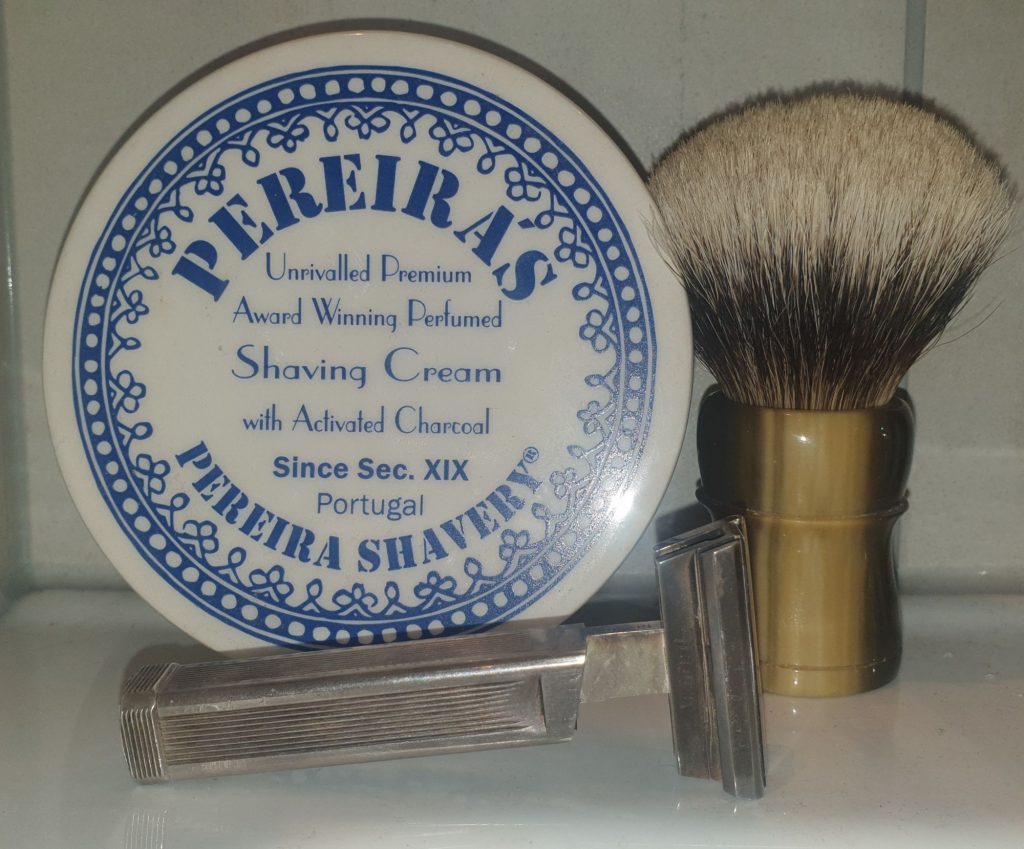
A humpday shave on the second to last day of the shortest month.
- Razor: Schick Type B2
- Blade: Personna Injector
- Brush: Vie-Long #12705B
- Pre-Shave: Proraso Pre Shave Cream
- Lather: B&M Latha Oceana
- Aftershave: Barber No3 Marmara
- Additional Care: Alum Block
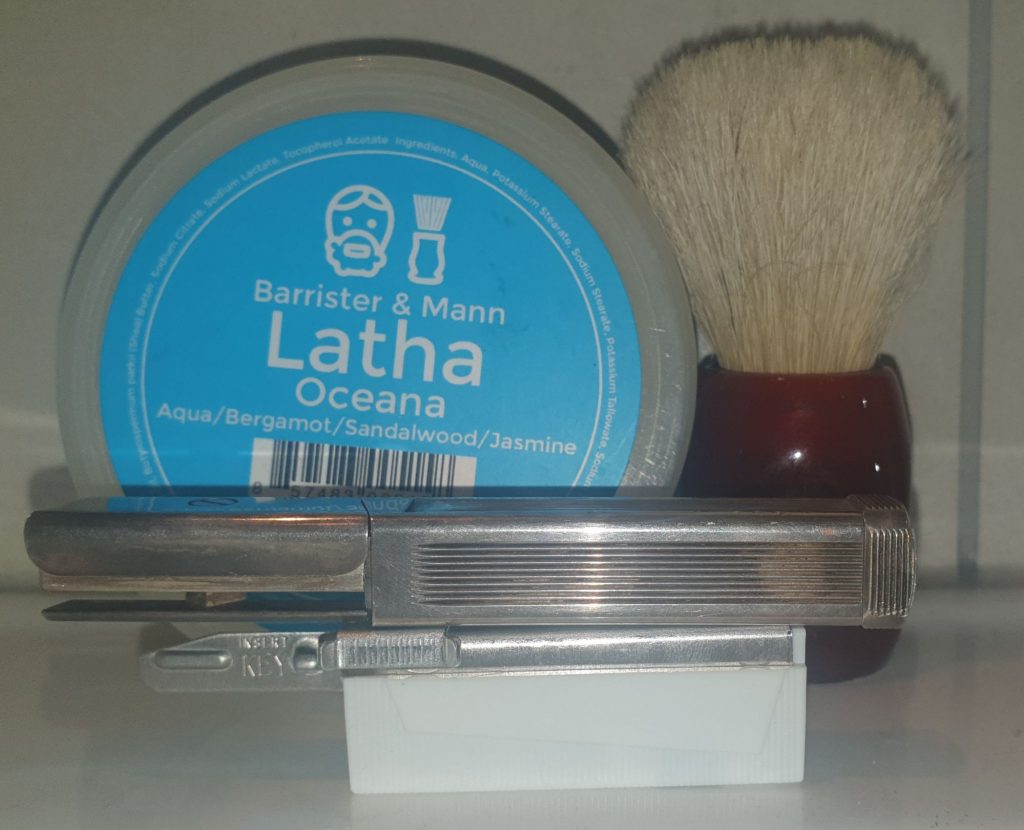
New week, and time for the other Holy Grail razor I’m lucky enough to own.
Whenever I see a patent with a particularly odd name, like “disposable cylindrical razor apparatus”, I wonder if Leonardo da Quirm1 was involved somehow.
So what is a disposable cylindrical razor apparatus? When all is said and done, it is a disposable razor in an odd format. Disposable razors is nothing new, and I’ve covered a few over the years – some in weird shapes. But what makes this one stick out is that it comes with four cutting surfaces, and looks to be meant to be used as a shavette.
The inventor also makes it sounds more complicated than it is. To quote the patent text:
>The present invention relates to an improved razor apparatus in which the blade is of cylindrical construction having a plurality of razor blade cutting surfaces, and has particular reference to an improved disposable cylindrical razor apparatus in which there are provided many safety features as well as a plurality of sharpened cutting surfaces that are of the double edged character.
It’s a tube. With a slot cut out. And a cylindrical blade assembly on the inside. And there is several cutting edges in the cylinder.
As can be seen from figure 3, the handle portion of the tube could double as a protective cover. The business end of the tube had a slit, which meant that it could compress and hold the blade securely when the handle was tightened. The cylindrical blade had four double edges, evenly spaced around the circumference.
As for potential drawbacks, I can see this being difficult to rinse out. If the bottom of the handle had been open, you could simply have run water through it to rinse away soap and stubble, but since it is closed it would require more work.
And why is the disposable cylindrical razor apparatus disposable? Since it is set up so you can rotate the blade to get fresh edges, I can see simply replacing the cylindrical blade with a fresh one.
I can see this razor apparatus being handy as a travel razor. It would pack into a small space, keep the edges safe, and probably okay to bring as a carry-on while flying. If you rally wanted, you could also store a small shavestick or tube of shaving cream in the hollow razor.
You can read the full patent for the disposable cylindrical razor apparatus on Google Patents.
---
Footnotes:
- The greatest inventor on the Disc2, although his genius did not extend to naming3 his inventions.
- GNU Pterry 🙁
- For instance, his machine capable of travelling submersed in a marine environment was named the “Going-Under-The-Water-Safely Device”…

Remember the abandoned patent application I shared with you last week? Remember how I said one reason for the abandonment might be the existence of a lot of prior art? Well, I found one piece of prior art; Dyer T Kendrick’s 1902 patent for a push up shave stick.
Presented as certain new and useful improvements in the art of shaving sticks, the 1902 patent does the functionally same thing as Kevin’s invention. It also does it one better, as the main body of the device is easily reusable. In that respect it is much like Colgate’s Handy-Grip.
The invention was fairly simple. In the words of the patent text:
>My invention is a tubular case adapted to hold a stick or cylindrical piece of soap and provided with a push-block for moving said soap outwardly through the tube, in combination with a spring on said block arranged to hold said block in position in the tube, as hereinafter particularly described.
Drawing from US patent 700,947
As can be seen from the drawing, the body of the invention is a tube, open at both ends. One end can be closed with a lid. Riding on the inside is a cylindrical block with a grove along the circumference. And riding in the grove is a circular spring.
A shaving stick is inserted in the top of the tube. Whenever the exposed end is worn down, the shaver can push the cylindrical block up with a finger. The tension of the spring keeps the block in position. And when the soap is used up, the block can be pushed back down and a new soap inserted.
Simple, easy to understand, and likely easy to manufacture. If someone sold these today, preferable sized for Arko or other popular shave sticks, I would buy one.
You can read the full patent for Kendrick’s 1902 push up shave stick at Google Patents.
- Razor: Schick Type A
- Blade: Schick Injector
- Brush: Omega #10048
- Pre-Shave: Proraso Pre Shave Cream
- Lather: Proraso Menthol & Eucalyptus
- Aftershave: Barber No3 Marmara
- Additional Care: Alum Block
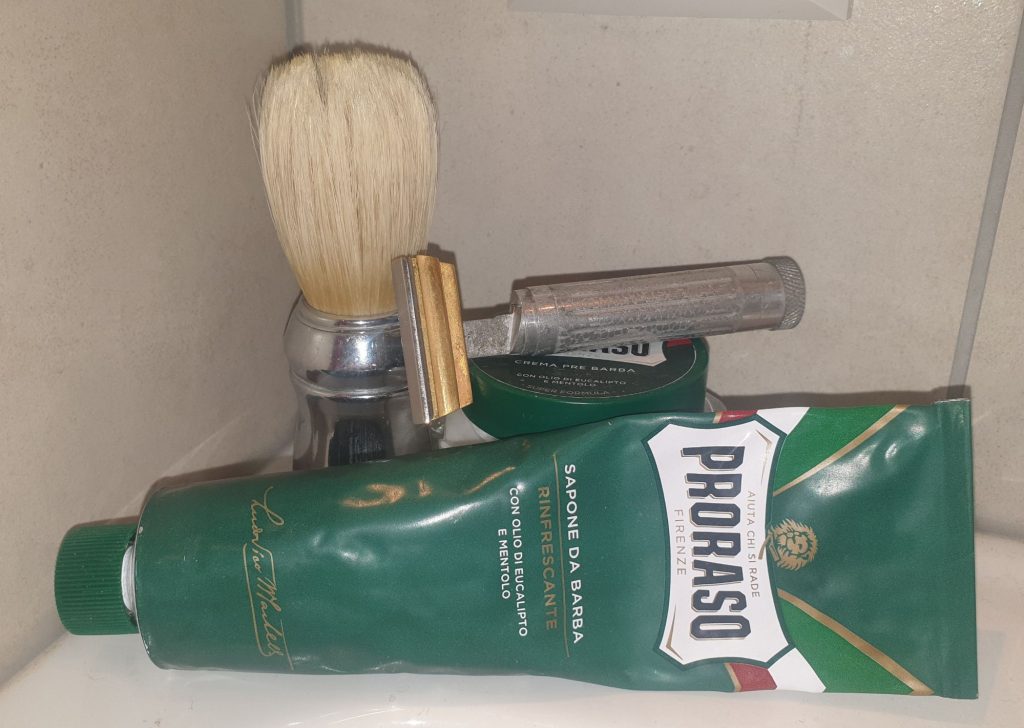
Another fine Friday shave
I’ve discussed various self loading brushes before. But all of them, including the one from 1849 as well as the Brush Plus from the eighties, used soap that was either liquid or semi-liquid. Woodburry P Lefavour’s shaving brush patent from 1890 is the first I’ve seen that used a solid soap.
Inventions are – when all is said and done – solutions to a problem or an improvement to the state of the art. Lefavour claimed that his brush was a new and useful improvement to the humble shaving brush.
The invention isn’t complicated to understand. Take a push-up shave stick – not dissimilar in concept to the abandoned patent we just looked at – and wrap a shaving brush around it.
Or as the patent text says;
>The object of my invention is to combine with a shaving-brush a Soap-stick and longitudinally adjustable soap-holder arranged centrally within the brush and its handle, so as to produce a lather on the face simply by dipping the brush in water and brushing it against the face without the need of rubbing the brush on a cake of soap, as is generally done, thus providing a quick, simple, and ready means for lathering the face preparatory to shaving the beard.
Patent drawing from US patent 422,085
The soap holder was a simple tube, with a slit down one side. Inside the tube was a cylinder, with a knob protruding out to the slit. On the top of this cylinder there was a shaving stick.
Around the open end of the soap holder was a shaving brush knot, secured in a ferule. Secured in a suitable manner, I might add – even if the patent don’t suggest what this suitable manner would be.
And that was pretty much the whole thing. Tu use, as the quote above suggest, the shaver would dip it in water, and then proceed to face lather.
Would Lefavour’s shaving brush work? Probably.
Would it be uncomfortable to lather with, given the stick of soap in the middle? Probably.
Would it be better than a regular brush and a cake of soap? Probably not. And that is probably why this style of self feeding shaving brush is not a thing any more.
You can read the full patent for Lefavour’s shaving brush on Google Patents.

Sometimes people files patent applications with the best of intentions, but at the same time a lack of understanding as to what the prior art is. One I recently found was Kevin Monte de Ramos’ Shaving Stick. The application was in 2005, and abandoned a couple of years later.
Most patents seems to be focused on solving a problem. And the problem Kevin sought to fix, was that you would have to use your hand to apply lather. Or in his own words:
>Shaving aids available in the market today come in three primary forms: (a) soaps whipped into a lather and then applied to the face using a brush, (b) creams/gels/lotions dispensed from the container into the hand and then spread across the area to be shaved, or as a (c) liquid astringent splashed onto the body. The use of these shaving aids have a single unifying inconvenience: each requires an intermediary tool to apply the shaving aid onto the skin; namely the user’s hand. Additionally, shaving creams/gels/lotions accumulate to hide the hairs to be shaved. As such, it is often necessary to manually remove excess lubricant before passing the blade near critical hair lines; a man’s sideburn and mustache or a women’s bikini line. Another inconvenience is that shaving kits, cans of shaving cream, and bottles of shaving astringents take up limited space in our travel bags.
For starters, I wouldn’t say that having to use my hand to wield a brush is an inconvenience. But, for the sake of the argument, let’s pretend that it is.
Kevin goes on to describe how he got the idea for his invention while out shopping, wondering why shaving aids didn’t come in a deodorant container. So he went home and tried, and applied for a patent for the idea.
Drawing from From US patent application US11/306,176
Can I just say that Kevin produced an oddly endearing drawing to go with his application?
According to the application, 1a is ‘applicator assembly body’ – i.e.: a deodorant tube. 1b is the lid for the tube, and 1c is the turn knob. 2 is the actual shaving soap, while 3 is the whole assembly. The whole thing is not exactly an un-intuitive step from someone used to deodorants and shaving soaps.
I can think of a couple of reasons why Kevin choose to abandon his patent application. Aside from the money needed to file a full patent, that is.. One is the fact that you would still be inconvenienced by using your hands to apply the shaving stick to your face. Unless, that is, you balances the shaving stick on your vanity and then bend down to rub your face over it.
The other reason is that a shaving stick in a convenient container isn’t a new idea by far. A hundred years ago – eighty years before Kevin filed the application for his shaving stick – you could get such things as Colgate’s Handy-Grip and Safetee in a tin. In short, there was prior art, and probably a lot of it too.
You can read the full patent application for Kevin’s shaving stick over at Google Patents.
It is a fun and interesting razor :)
- Razor: Schick Type A
- Blade: Schick Injector
- Brush: Artesania Romera Manchurian Badger, imitation horn
- Pre-Shave: Proraso Pre Shave Cream
- Lather: Pereira Shavery Orange Blossom w/ activated charcoal
- Aftershave: Barber No3 Marmara
- Additional Care: Alum Block
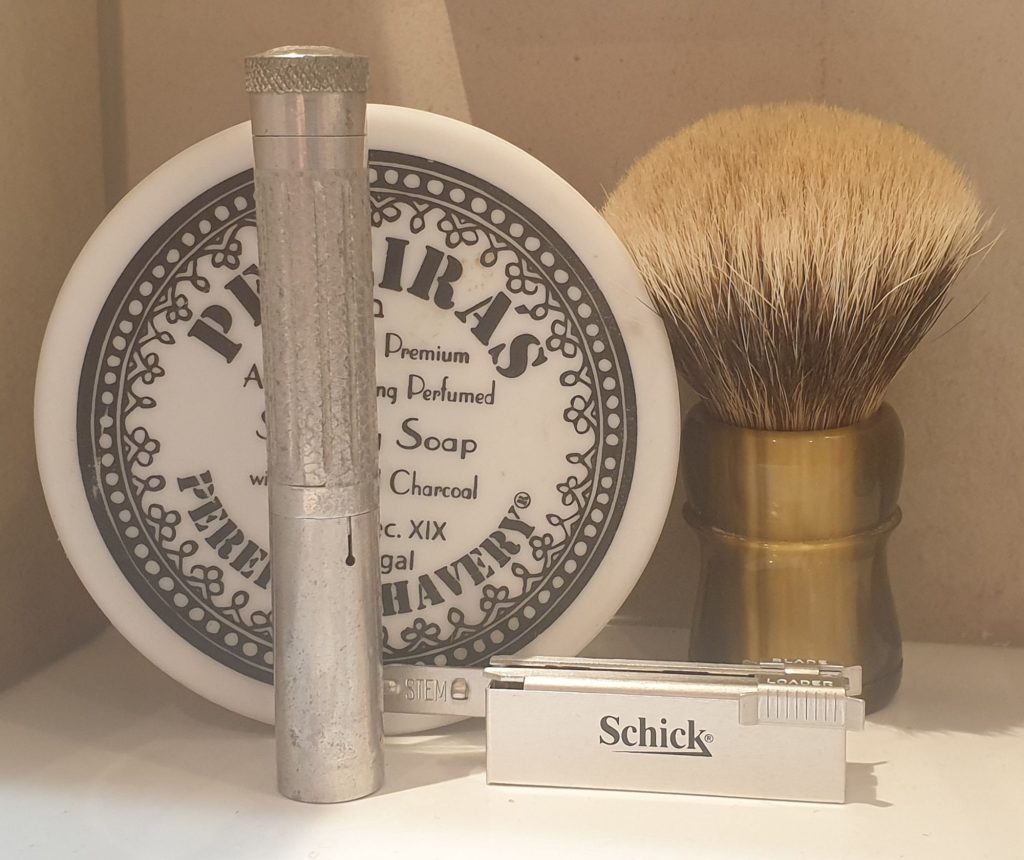
New week, and a wonderful new shave with a vintage razor that is both fun and interesting.

As some of y’all are hurtling towards an election, lets examine a political conundrum from the 1896 election…
Why do men of all parties vote for Williams’ Shaving Soap? Or at least, why did they one hundred and twenty eight years ago?
Men of all parties, we are told, had for more than half a century voted unanimously for Williams. Which is a claim that makes sense, since Williams claimed to be the oldest real shaving soap.
Williams, we’re told, are voted for because it has absolute purity, rich and creamy lather, as well as soothing and healing qualities. While the last claim may be a little hard to prove, the last Williams’ soap that was manufactured was pretty good soap, at least in my opinion…
The advertisement also pokes a little fun at the various parties that fielded candidates in the election. The “sound money men” were Republicans, who wanted to keep the US on the gold standard. “Silverites” refers to the Democrats, who wanted the US of the gold standard. The “Populists” were the People’s Party, a prominent third party advocating agrarianism. And lastly “Prohibitionists” of course refer to the Prohibition Party, who’s major platform was – unsurprisingly – prohibition.
But no matter their political leanings, the advertisement claims, all men voted for Williams’ Shaving Soap… which could be had in several forms. The delightfully perfumed shaving tablet – which seems to be a precursor to the Mug Soap – for 25 cents. The Genuine Yankee cake, yours for ten cent. Shaving sticks for 25 cents a piece. And if you forked over a whooping 40 cents, you got a pound of soap in six individual cakes.
Oh, and the election? Won by William McKinley, who went on to become the third (and second to last) US president to be assassinated.